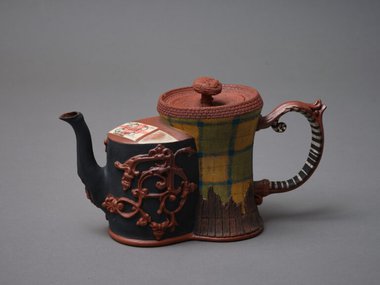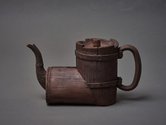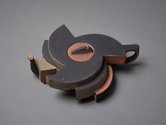John Hurrell – 14 November, 2023
When building his (nevertheless) functional sculptures, Stratton deliberately specialises in resurrecting outdated techniques of industrial ceramic construction and colouring, so patient research into the history of his medium and its glazes is crucial. Plus for his formal elements he is inspired by a vast range of abandoned metal parts ranging from lampstands and lawnmower pieces to car steering mechanisms. Or for technique and chemical know-how, bits of smashed glazed chinaware found in the mud of the Thames.
Perhaps sometimes perceived as an obsessive teapot maker (as if that in itself were somehow ‘wrong!’ or ‘nutty!’), the actually more versatile ceramicist Richard Stratton at Anna Miles continues his personal (often humorous) and highly inventive investigation into this drawing room utensil’s functional form and glazed surface decoration. His works regularly defy expectations of how a teapot is supposed to look.
Based in Wellington, trained as a potter in Dunedin, and recipient of an impactful residency in Denmark and other awards, Stratton is well known nationally, although he doesn’t make much more than a dozen works a year, for each consumes about a month for research and execution. Stratton possesses a unique kind of wit in these playful convention-defying constructions, seen in his exuberant handing of decorated surface and sculptural manipulation. Stacked and circular hollow ‘slabs’ often tease out the conventions of art deco; others—timberish folk funk or ornate arabesqued Rococo—slyly pushing against the shapely boundaries of what a functional serviceable tea-infusing device might be.
For this Anna Miles show, Stratton‘s ten teapots and one vase are carefully positioned in two large glass vitrines, and on one circular table and two vertical plinths. The teapots are usually small, mostly low, squat and flat. The few vertical ones are delicately drawn on and often cubist-inspired. One work based on several cylinders is more complicated, with small painting or banner-like rectangular images attached to its sweeping horizontal and vertical curves.
The show features several types of differently constructed teapot: there are two with opposing joined up cylinders made of bamboo or blankets; three featuring tall vertical ornamental cylinders; three others with circular stacked ‘blades’; one like a teetering tilted boxlike brick attached to a spout; and another vaguely like a small squatting lampshade. All sort of strange appurtenances like contemplative monkeys or spiralling knobby scrolls have been added.
When building his (nevertheless) functional sculptures, Stratton deliberately specialises in resurrecting outdated techniques of industrial ceramic construction and colouring, so patient research into the history of his medium and its glazes is crucial. Plus for his formal elements he is inspired by a vast range of abandoned metal parts ranging from lampstands and lawnmower pieces to car steering mechanisms. Or for technique and chemical know-how, bits of smashed glazed chinaware found in the mud of the Thames. Glancing at his exhibits you can sense his restless mind probing the potential formal possibilities within all kinds of curiously shaped or textured industrial detritus.
With the surface decoration of delicate glazing, he often shrewdly incorporates via sections of illustrative—historical, geographical, meteorological, botanical, conchological or autobiographical—narratives that the determined viewer can unravel. Painters as diverse as Wong, Walters, Matchitt or Braque can be referenced on the most unexpected surfaces.
Aside from the possibility of creating laughs, or simply highlighting quirky interests, some of these wonky contraptions might be seen as critiques of socially imbibing fashion, especially as the hot drink came from China to England (via the Dutch) in the mid seventeenth century, resulting in the ‘oh so civilised’ English becoming passionate about tea consumption. Whatever the case, Stratton’s referenced enthusiasms covering these tea-brewing appliances are encyclopaedic, deftly sandwiched into multiple juxtaposed image combinations that (while you are possibly slurping your hot beverage) reel you in closer to enjoy citation, allusion, surface, transparency and form.
John Hurrell










 Two Rooms presents a program of residencies and projects
Two Rooms presents a program of residencies and projects Advertising in this column
Advertising in this column



This Discussion has 0 comments.
Comment
Participate
Register to Participate.
Sign in
Sign in to an existing account.